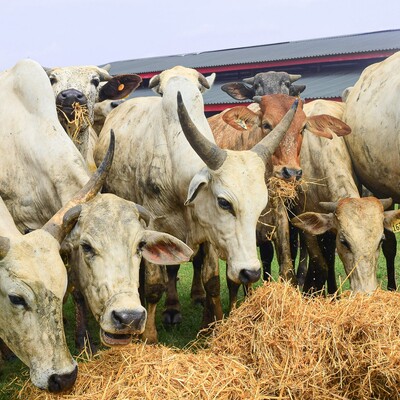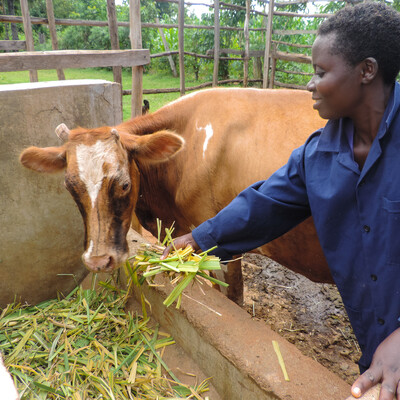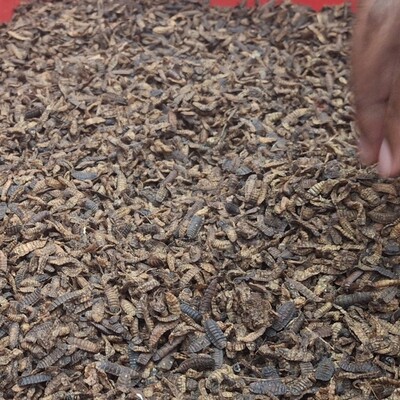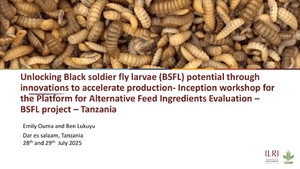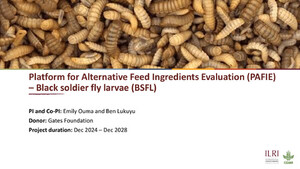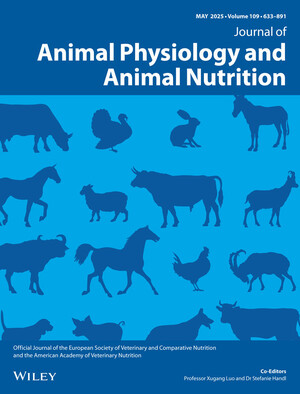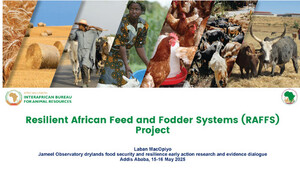
Meat, milk and more for Africa: Four countries with successful livestock policy innovations to emulate
Graphic modified slightly from the Malabo Montpellier Panel report.
A newly published Malabo Montpellier Panel report, Meat, Milk & More: Policy innovations to shepherd inclusive and sustainable livestock systems in Africa, ‘highlights options for sustainably promoting growth in the livestock sector, drawing from what four African countries—Ethiopia, Mali, South Africa, and Uganda—have done successfully in terms of institutional and policy innovation as well as programmatic interventions.
‘By adapting these lessons to countries’ specific contexts and scaling them up across the continent, African governments can meet their national and international commitments to agricultural growth and transformation.’
Iain Wright, deputy director for integrated programs at the International Livestock Research Institute (ILRI), welcomes the report and applauds the Malabo Montpellier Panel for producing a report on livestock in Africa.
The livestock sector accounts for about 40% of agricultural GDP in Africa, ranging from 30 to 80% in individual countries, but rarely gets more than 5 to 10% of agricultural investment and as a consequence is under-performing.
The report highlights the critical role of livestock in achieving the 17 Sustainable Development Goals, including achieving healthy diets, supporting millions of jobs and driving economic growth as well as the potential to transform women’s lives.
It offers sound, evidence-based recommendations to policymakers that could support the transformation of the sector.
—Iain Wright, deputy director general at ILRI
* * *
From Chapter 3: An overview of livestock in Africa
Livestock numbers and distribution
Africa is a livestock-rich continent representing about one-third of the world’s livestock population . . . .
Across the continent, livestock is considered as one of the most valuable agricultural assets for the rural and urban poor, especially for women and pastoralists . . . .
The African livestock sector contributes between 30 and 80 percent to countries’ agricultural GDP . . . while East Africa’s livestock sector generates more than US$1 billion annually through exports . . . .
Livestock keepers in Africa primarily depend on cattle, sheep, goats, donkeys, camels, and poultry . . . .
In addition, there is a growing trend of pig farming across Africa south of the Sahara . . . .
Poultry farming and consumption, particularly chicken, play a key role in many African countries. . . .
‘As indicated in figure 1, Africa’s total livestock population in 2018 was estimated at 2 billion poultry birds (1.9 billion chickens, 26 million guinea fowl, 27 million turkeys, 22 million ducks, and 11.5 million pigeons), 438 million goats, 384 million sheep, just under 356 million cattle, 40.5 million pigs, almost 31 million camels, and 38 million equines (including 30 million donkeys, 6.5 million horses, and 885,000 mules).

‘Figure 1. 2018 Livestock population in Africa. Source: FAOSTAT 2019.
‘Eastern and western Africa have the largest goat populations, while cattle dominate East Africa’s livestock sector. A recent study found that across the continent, cattle densities are highest in the East African highlands, particularly in Ethiopia, as well as in Nigeria. As figure 2 indicates, eastern Africa had the highest concentration of livestock per agricultural land area in 2017, with 0.37 livestock units per hectare (LSU/ha). In comparison, northern Africa had 0.31 LSU/ha, western Africa 0.28 LSU/ha, and central Africa 0.25 LSU/ha, while in southern Africa, the density was only slightly above 0.10 LSU/ ha. Figure 2 also shows that, with the exception of southern Africa, livestock densities steadily increased in all regions between 1990 and 2017.
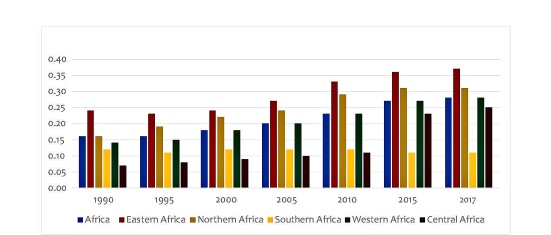
‘Figure 2: Livestock per agricultural land area (LSU/ha) for major livestock types in Africa’s sub-regions. Note: Major livestock include cattle, buffalo, sheep, goats, and equines. Between 1990 and 2017, livestock densities have substantially increased in all subregions: central Africa (+257 percent), western Africa (+100 percent), northern Africa (+94 percent), and eastern Africa (+54 percent) with the exception of southern Africa (-8 percent). Source: FAOSTAT (2019).’
Important lessons can be learned from the livestock sector policies and strategies in several African countries. . . .
Drawing on the findings of the four case studies presented in this report, the Malabo Montpellier Panel makes seven recommendations for action by governments and the private sector.
From ‘Creating an enabling environment’
1 Overarching policy frameworks: Given the duality of livestock production in many countries, with large market-oriented producers operating alongside small and subsistence producers, and formal markets operating alongside informal markets, an overarching policy framework is needed to create an inclusive, holistic, innovative, productive, and profitable livestock sector, that is also environmentally sustainable and promotes further involvement of women and youth. . . .
2 Regulation: A nimble but clear and health conscious regulatory environment will be critical to ensure that a flourishing livestock sector maintains high safety, quality, and welfare standards, produces nutritious food, preserves environmental sustainability, and protects producers’ and consumers’ health. . . .
3 Private sector–led development: A viable private sector, including farmer and herder organizations, will facilitate increased investments, and drive growth, job creation, and entrepreneurship in the livestock sector. . . .
4 Finance and livestock assets:
Despite its significant contribution to agricultural and national gross domestic product (GDP), the livestock sector in most African countries remains heavily underfunded.
Financing common goods such as animal health, animal improvement, and research creates a strong foundation upon which both market-oriented and subsistence livestock sectors can prosper. . . .
5 Trade: There is great potential to increase the intra-African trade of livestock products and live animals through strong partnerships that improve trade flows across the continent. . . .
6 Data and research: Availability and access to comprehensive and good quality information and data on all aspects of the livestock sector, including breeding, is critical for facts-based policy design. . . .
7 Conflict: Conflicts between pastoralists and crop farmers can be reduced by focusing on a holistic approach to supporting all stakeholders’ livelihoods, including a robust network of support services adapted to the mobile livelihoods of pastoralists. . . .
Sectoral interventions
8 Ruminants: As countries strive to meet the increasing demand for meat, milk and dairy products, productivity needs to be sustainably increased factoring in animal and human health aspects while using new technologies and breeding instead of growing herd sizes. . . .
9 Poultry: Employment and entrepreneurship opportunities in the poultry sub-sector are particularly attractive for young people and women due to the relatively small capital investment and land ownership needs and should be supported through targeted government programs. . . .
10 Dairy: Africa’s dairy sector offers a multitude of opportunities for employment generation and entrepreneurship along its entire value chain. . . .There is the opportunity for some countries, particularly in East Africa, to specialize in dairy production and to become key trade partners within Africa . . . .
11 Pork: As demand for pork steadily increases across the continent and the focus is on increasing productivity and promoting value addition, interventions targeting the adoption of improved technologies and better management of feed are needed. . . .
From ‘What works at the country level?’
The experiences of four African countries that have been at the forefront of strengthening their livestock sectors through dedicated and effective government action offer a wealth of lessons.
Their successful policies and interventions, if replicated at scale, could enable African countries to make faster progress in the fight against poverty and hunger. . . .
The table below offers a summary of some of the key actions:
Ethiopia
‘The government of Ethiopia has carefully and systematically adapted institutions and policies for pastoralist and non-pastoralist producers to ensure that the livestock sector can contribute toward achieving its commitments on poverty alleviation, food security, and improved nutrition. A multi-pronged approach to simultaneously building capacity in animal health, research, and marketing has attracted significant investment both from the private sector and development partners, further ensuring that the sector thrives.
Mali
‘Mali stands out for a focus on improving animal health and feed, and promoting an increase in the productivity of local cows through breeding. The government has also invested in infrastructure development and equipment to commercialize the livestock sector and facilitate the export of live animals in the region.
South Africa
‘Success in South Africa’s livestock sector is underpinned by a vibrant private sector and national efforts to include and commercialize production from small and emerging farmers. A relatively well-established animal health system, in conjunction with better marketing and access to finance, enable
farmers to prosper from livestock production.
Uganda
‘Uganda stands out for its commitment to strengthening its dairy sector through dedicated policies, including the Dairy Master Plan to liberalize the dairy industry and to restructure and privatize the state-owned dairy processing company Dairy Corporation, which have contributed to the transformation of the dairy industry. Uganda’s programmatic interventions are directed toward enhancing the livestock sector with a primary focus on the dairy value chain and maintaining self-sufficiency in milk production.’
The report’s acknowledgements
‘The writing of the report was led by Katrin Glatzel (IFPRI/AKADEMIYA2063), Mahamadou Tankari (IFPRI/AKADEMIYA2063), Meera Shah (Imperial College London), and Samira Choudhury (Imperial College London) under the guidance of Ousmane Badiane and Joachim von Braun, co-chairs of the Panel. The input and advice of Panel members Noble Banadda, Gordon Conway, and Wanjiru Kamau-Rutenberg are especially acknowledged. We would also like to thank Carlos Seré (University of Bonn), Carlo Azzari (IFPRI), Wim Marivoet (IFPRI), Iain Wright (ILRI), Abdu Fall (ILRI), Juliana Lopes (FAO), Henning Steinfeld (FAO) and Bouchaib Boulanouar (AfDB), for their feedback on the report, and Oumar Diall (Comité National de la Recherche Agricole (CNRA) du Mali), Mamadou Diop (Institut Sénégalais de Recherches Agricoles), Mame Nahé Diouf (Institut Sénégalais de Recherches Agricoles), Aymen Frija (ICARDA), Gebregziabher Gebreyohannes (Ministry of Agriculture, Ethiopia), Youssouf Kabore (AfDB), Johann Kirsten (Stellenbosch University), Charles Lagu (Uganda National Animal Genetic Resources Centre and Data Bank), Getachew Gebru Tegegn (formerly Ethiopian Society of Animal Production), Saidou Tembely (Académie des Sciences du Mali), Adama Traore (Syngenta Foundation), and Nick Vink (Stellenbosch University), for their feedback on the country case studies. This report was designed by Tidiane Oumar Ba (IFPRI/AKADEMIYA2063) with
support from Hawa Diop.’
Read the whole report, Meat, Milk & More: Policy innovations to shepherd inclusive and sustainable livestock systems in Africa, Malabo Montpellier Panel Report, 2020.
About the Malabo Montpellier Panel
The Malabo Montpellier Panel convenes 16 leading experts in agriculture, ecology, nutrition, and food security to facilitate policy choices by African governments to accelerate progress toward food security and improved nutrition. The Panel identifies areas of progress and positive change across the continent and assesses what successful countries have done differently. It identifies the most important institutional and policy innovations and program interventions that can be replicated and scaled by other countries. The related Malabo Montpellier Forum provides a platform to promote policy innovation by using the evidence produced by the Panel to facilitate dialogue among high-level decision-makers on African agriculture, nutrition, and food security.
The core mission of the Malabo Montpellier Panel is to support evidence-based dialogue among policy makers at the highest level. The Panel’s reports seek to inform and guide policy choices to accelerate progress toward the ambitious goals of the African Union Commission’s Agenda 2063, the Malabo Declaration and the global development agenda. The Panel works with African governments and civil society organizations to provide support and evidence-based research that facilitate the identification and implementation of policies that enhance agriculture, food security and nutrition.
The secretariat of the Panel in now hosted at a new organization AKADEMIYA2063, which is also now managing the Regional Strategic Analysis and Knowledge Support System (ReSAKSS), which supports implementation of the Comprehensive Africa Agriculture Development Programme (CAADP). ILRI is a strong supporter of both ReSAKSS and CAADP and hosts the East and Central Africa node of ReSAKSS. The executive chair of AKADEMIYA2063 is Ousmane Badiane, former Africa director at the International Food Policy Research Institute (IFPRI).







